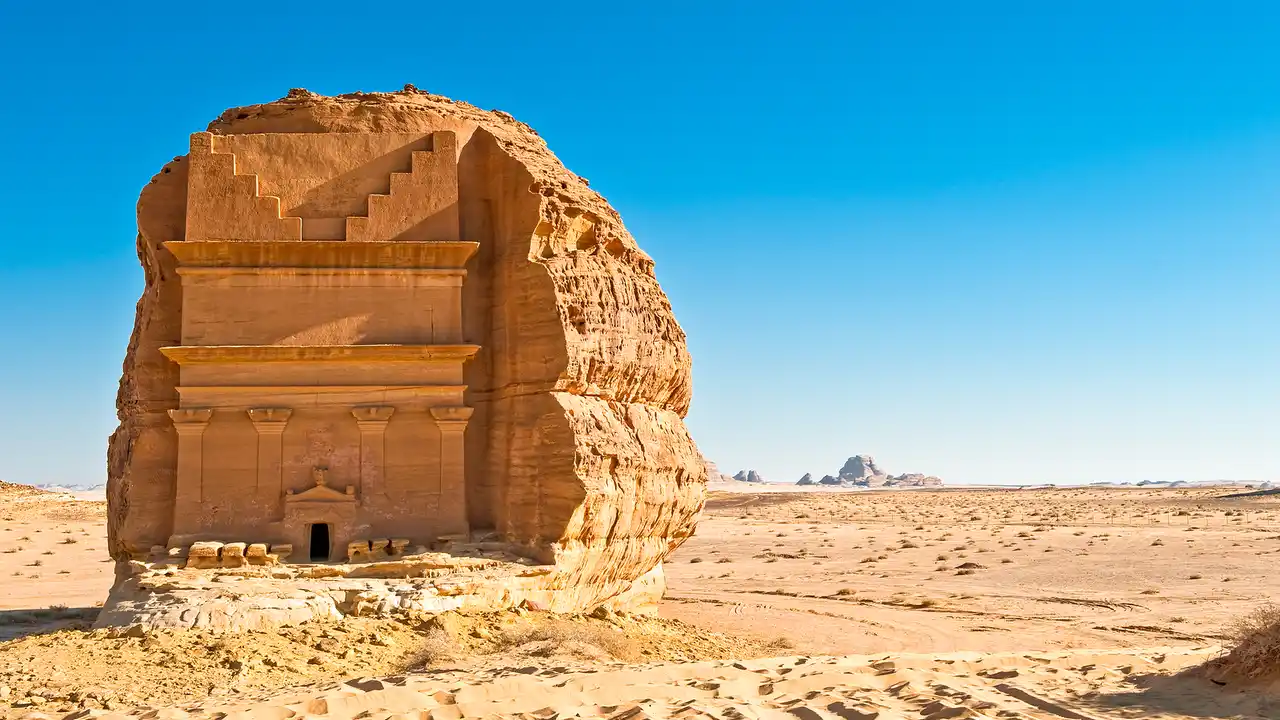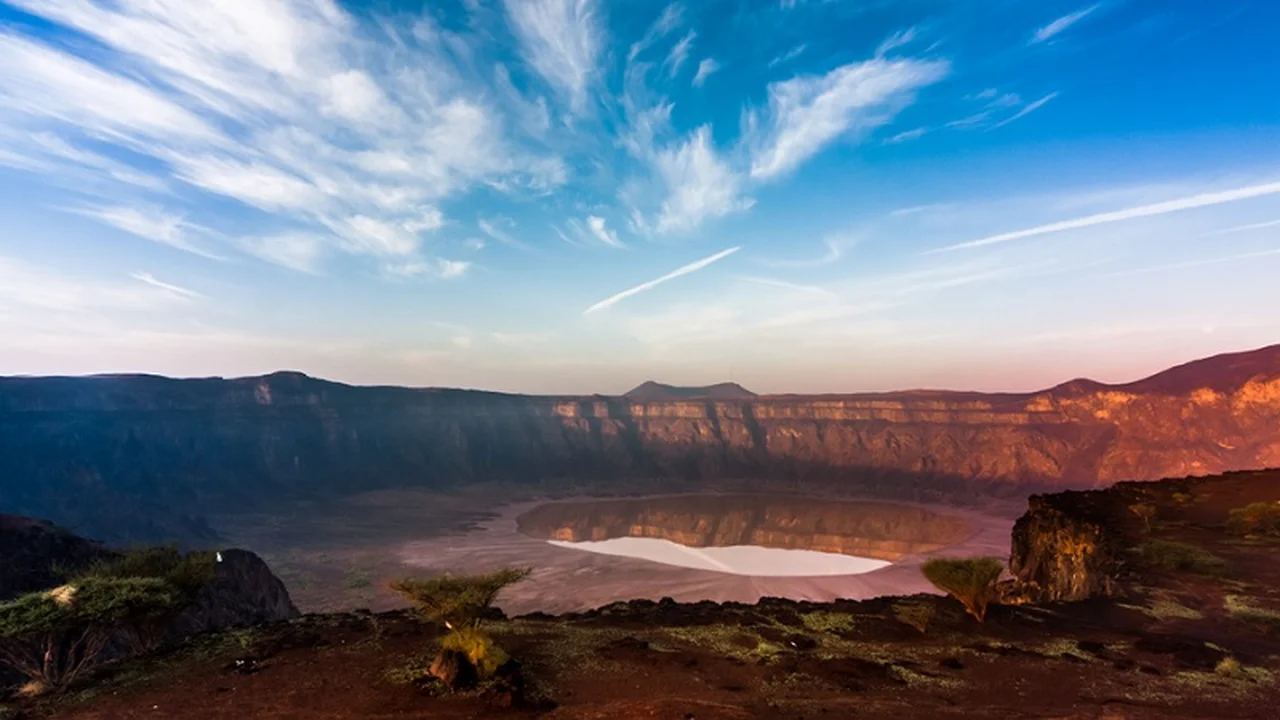
Unveiling Saudi Arabia's Rich History A Journey Through Time
Saudi Arabia, often associated with modern skyscrapers and vast deserts, holds a treasure trove of historical sites that whisper tales of ancient civilizations, religious significance, and pivotal moments in history. This article will guide you through seven must-see historical sites in Saudi Arabia, each offering a unique glimpse into the kingdom's fascinating past. Get ready to embark on a journey through time, exploring architectural marvels, archaeological wonders, and places of profound cultural importance.
Mada'in Saleh Al-Hijr A UNESCO World Heritage Site
Our first stop is Mada'in Saleh, also known as Al-Hijr, a UNESCO World Heritage Site located in the AlUla region of Saudi Arabia. This ancient city was once a thriving Nabataean settlement, second only to Petra in Jordan. The site boasts an impressive collection of well-preserved rock-cut tombs, intricate facades, and ancient inscriptions that offer invaluable insights into the Nabataean civilization.
Exploring the Rock Cut Tombs of Mada'in Saleh
The highlight of Mada'in Saleh is undoubtedly its rock-cut tombs. These monumental structures, carved directly into sandstone cliffs, served as final resting places for wealthy Nabataean families. Each tomb is adorned with intricate carvings, reflecting the artistic skills and architectural prowess of the Nabataeans. As you wander through the site, you'll be amazed by the sheer scale and detail of these ancient tombs.
The Significance of Al-Diwan in Nabataean Society
Al-Diwan, a large rectangular hall carved into the rock face, is another important feature of Mada'in Saleh. This structure served as a gathering place for religious ceremonies, banquets, and other important social events. The presence of Al-Diwan highlights the importance of community and social interaction in Nabataean society.
Unearthing Ancient Inscriptions at Mada'in Saleh
Mada'in Saleh is also home to a wealth of ancient inscriptions, providing valuable information about the Nabataean language, religion, and daily life. These inscriptions, carved into the rock faces surrounding the tombs, offer a glimpse into the beliefs and customs of this fascinating civilization. Deciphering these inscriptions is an ongoing process, constantly revealing new insights into the history of Mada'in Saleh.
Product Recommendation: For a deeper understanding of Mada'in Saleh and Nabataean history, we recommend "Nabataea: A History" by Jane Taylor. This comprehensive book provides detailed information about the Nabataean civilization, their culture, and their architectural achievements. Use Case: Perfect for researchers, history enthusiasts, and travelers planning a visit to Mada'in Saleh. Product Comparison: While other books on the Nabataeans exist, Taylor's work is considered the most authoritative and comprehensive. Detailed Information: Available on Amazon and other major booksellers, priced around $30-$40.
Diriyah The Historical Capital of the First Saudi State
Next on our list is Diriyah, the historical capital of the First Saudi State. Located just outside of Riyadh, Diriyah played a pivotal role in the unification of the Arabian Peninsula under the Al Saud dynasty. This UNESCO World Heritage Site offers a glimpse into the origins of modern Saudi Arabia and the struggles that shaped the kingdom.
Exploring At-Turaif District in Diriyah
The heart of Diriyah is the At-Turaif District, a fortified settlement that served as the royal residence and administrative center of the First Saudi State. This district features a collection of mud-brick palaces, mosques, and other historical buildings, showcasing the traditional architecture of the region. As you explore At-Turaif, you'll gain a deeper understanding of the political and social dynamics of the First Saudi State.
The Significance of Al-Bujairi Square in Diriyah
Al-Bujairi Square, located just outside the walls of At-Turaif, was a bustling marketplace and a center for social and cultural exchange. This square played a vital role in the economic life of Diriyah and served as a meeting place for people from all walks of life. Today, Al-Bujairi Square has been transformed into a modern cultural center, hosting events and exhibitions that celebrate the history and heritage of Diriyah.
Witnessing the Restoration Efforts in Diriyah
Diriyah is currently undergoing extensive restoration efforts, aimed at preserving its historical buildings and revitalizing its cultural heritage. These efforts are crucial to ensuring that future generations can appreciate the significance of Diriyah in Saudi Arabian history. As you visit Diriyah, you'll witness firsthand the dedication and commitment of the Saudi government to preserving its cultural heritage.
Product Recommendation: To enhance your experience in Diriyah, consider hiring a local guide through "Viator" or "GetYourGuide." These platforms offer various guided tours that provide in-depth historical context and insights. Use Case: Ideal for travelers who want a more personalized and informative experience. Product Comparison: Compared to self-guided tours, guided tours offer a deeper understanding of the historical significance of Diriyah. Detailed Information: Tour prices vary depending on the duration and inclusions, typically ranging from $50 to $150 per person.
Jeddah Al-Balad The Historical Gateway to Mecca
Our next destination is Jeddah Al-Balad, the historical center of Jeddah and a UNESCO World Heritage Site. This ancient port city served as a major gateway for pilgrims traveling to Mecca and Medina, and its unique architecture and vibrant culture reflect its rich history as a trading hub and a melting pot of different cultures.
Admiring the Roshan Architecture in Jeddah Al-Balad
One of the most distinctive features of Jeddah Al-Balad is its Roshan architecture. These intricately carved wooden screens, known as "roshans," adorn the facades of the historical buildings, providing shade and ventilation while adding a touch of elegance and beauty. As you wander through the narrow streets of Al-Balad, you'll be captivated by the intricate details and the unique character of these Roshan-adorned buildings.
Exploring the Historical Souks in Jeddah Al-Balad
Jeddah Al-Balad is also home to a network of historical souks, or traditional markets, where you can find a wide variety of goods, from spices and perfumes to textiles and handicrafts. These souks offer a glimpse into the traditional trading practices of Jeddah and provide an opportunity to experience the vibrant atmosphere of the city.
Discovering the Hidden Gems of Jeddah Al-Balad
Beyond its well-known landmarks, Jeddah Al-Balad is full of hidden gems waiting to be discovered. As you explore the narrow streets and alleyways, you'll encounter traditional coffee shops, art galleries, and historical mosques, each offering a unique glimpse into the culture and history of Jeddah. Be sure to take your time and wander off the beaten path to truly experience the charm of Al-Balad.
Product Recommendation: To capture the beauty of Jeddah Al-Balad, invest in a high-quality camera like the Sony Alpha a6000. This camera is lightweight, easy to use, and produces stunning images. Use Case: Perfect for travel photography and capturing architectural details. Product Comparison: Compared to smartphone cameras, the Sony Alpha a6000 offers superior image quality and versatility. Detailed Information: Available at major electronics retailers, priced around $600-$800 with a kit lens.
Al-Ukhdood Archaeological Site A Testament to Ancient Civilizations
Al-Ukhdood Archaeological Site, located in Najran, holds significant historical and religious importance. This site is believed to be the location of a mass burning of Christians in the 6th century AD, as mentioned in the Quran. The site offers a poignant reminder of the religious conflicts that have shaped the region's history.
Understanding the Historical Context of Al-Ukhdood
The story of Al-Ukhdood revolves around the persecution of Christians by the Jewish King Dhu Nuwas in the 6th century AD. According to historical accounts, King Dhu Nuwas ordered the burning of Christians who refused to convert to Judaism. This event is mentioned in the Quran and is considered a significant event in Islamic history.
Exploring the Archaeological Remains at Al-Ukhdood
The archaeological site of Al-Ukhdood features the remains of a fortified city, including walls, towers, and residential buildings. These remains offer insights into the daily life and architecture of the people who lived in Al-Ukhdood during the pre-Islamic era. As you explore the site, you'll gain a deeper understanding of the historical context and the events that unfolded here.
Reflecting on the Religious Significance of Al-Ukhdood
Al-Ukhdood is a site of profound religious significance for both Muslims and Christians. The story of the martyrs of Al-Ukhdood serves as a reminder of the importance of religious tolerance and the consequences of religious persecution. Visiting Al-Ukhdood is an opportunity to reflect on the lessons of history and to promote understanding and respect between different faiths.
Product Recommendation: For a deeper understanding of the religious and historical context of Al-Ukhdood, consider reading "The Quran: A New Translation" by M.A.S. Abdel Haleem. This translation provides insightful commentary and historical background. Use Case: Ideal for those seeking a deeper understanding of the Quran and its historical references. Product Comparison: Compared to other translations, Abdel Haleem's work is known for its clarity and accuracy. Detailed Information: Available on Amazon and other major booksellers, priced around $20-$30.
Rijal Almaa Heritage Village A Living Museum of Traditional Architecture
Rijal Almaa Heritage Village, located in the Asir region of Saudi Arabia, is a stunning example of traditional architecture and a living museum of the region's rich cultural heritage. This village is known for its unique stone houses, decorated with intricate geometric patterns and vibrant colors, reflecting the artistic skills and cultural traditions of the Asir region.
Admiring the Unique Stone Houses of Rijal Almaa
The stone houses of Rijal Almaa are the village's most distinctive feature. These multi-story structures are built from locally sourced stone and are decorated with intricate geometric patterns, painted in vibrant colors. Each house is a work of art, reflecting the artistic skills and cultural traditions of the people of Rijal Almaa.
Exploring the Traditional Crafts and Arts of Rijal Almaa
Rijal Almaa is also a center for traditional crafts and arts, including weaving, pottery, and wood carving. As you explore the village, you'll have the opportunity to witness these traditional crafts being practiced and to purchase unique souvenirs that reflect the cultural heritage of the Asir region.
Experiencing the Hospitality of the People of Rijal Almaa
One of the most memorable aspects of visiting Rijal Almaa is the hospitality of the local people. The residents of Rijal Almaa are known for their warmth and generosity, and they are eager to share their culture and traditions with visitors. Be sure to take the time to interact with the locals and to learn about their way of life.
Product Recommendation: To support the local artisans of Rijal Almaa, consider purchasing handicrafts directly from the village. Organizations like "Etsy" often feature artisans from the region. Use Case: Ideal for those looking for unique and authentic souvenirs. Product Comparison: Buying directly from artisans ensures that they receive a fair price for their work. Detailed Information: Prices vary depending on the item, but expect to pay a premium for handcrafted goods.
Al-Faw Archaeological Site Unearthing the Secrets of an Ancient Kingdom
Al-Faw Archaeological Site, located in the Empty Quarter of Saudi Arabia, is the site of a once-thriving ancient city that played a significant role in the region's trade and cultural exchange. This site offers a glimpse into the history of the Kindah Kingdom, a powerful pre-Islamic kingdom that controlled much of central Arabia.
Discovering the Remains of the Ancient City of Al-Faw
The archaeological site of Al-Faw features the remains of a well-planned city, including residential buildings, markets, temples, and a sophisticated irrigation system. These remains provide valuable insights into the urban planning, architecture, and daily life of the people who lived in Al-Faw.
Understanding the Role of Al-Faw in the Kindah Kingdom
Al-Faw served as a major trading hub and a political center for the Kindah Kingdom. The city's strategic location on the trade routes connecting the Arabian Peninsula with other parts of the world allowed it to flourish and to exert significant influence over the region. Exploring Al-Faw is an opportunity to learn about the history and culture of the Kindah Kingdom.
Witnessing the Ongoing Excavations at Al-Faw
Al-Faw Archaeological Site is currently undergoing ongoing excavations, with archaeologists constantly uncovering new artifacts and insights into the history of the city. Visiting Al-Faw is an opportunity to witness firsthand the process of archaeological discovery and to learn about the latest findings from the site.
Product Recommendation: Keep up to date with the latest archaeological discoveries at Al-Faw by subscribing to academic journals like "Antiquity" or "Saudi Aramco World." These publications often feature articles about ongoing research in the region. Use Case: Ideal for researchers, academics, and anyone interested in the latest archaeological findings. Product Comparison: Compared to popular media, academic journals provide more in-depth and accurate information. Detailed Information: Subscription prices vary, but many journals offer online access.
Hegra Another Nabataean Gem in Saudi Arabia
While Mada'in Saleh often takes the spotlight, Hegra, also part of the same archaeological site, deserves equal attention. It's another incredible example of Nabataean ingenuity and offers a quieter, less crowded experience.
Comparing Hegra and Petra The Nabataean Legacy
While Petra is grander in scale, Hegra offers a more intimate glimpse into Nabataean life. The preservation is remarkable, and the sheer number of tombs rivals Petra. Consider it Petra's equally impressive but lesser-known sibling.
The Unique Features of Hegra's Tombs
Hegra's tombs showcase a variety of architectural styles, reflecting the diverse influences on Nabataean culture. From Romanesque elements to intricate carvings of mythical creatures, each tomb tells a story about the individuals and families who were buried there.
Planning Your Visit to Hegra Practical Tips
Unlike Mada'in Saleh, Hegra is often less crowded, allowing for a more relaxed and immersive experience. Be sure to wear comfortable shoes, bring plenty of water, and consider hiring a local guide to learn more about the history and significance of the site. The AlUla region is investing heavily in tourism, so expect improved facilities and access in the coming years.
Product Recommendation: Invest in a good pair of hiking boots like the Merrell Moab 2 Vent. Comfortable footwear is essential for exploring the rocky terrain of Hegra. Use Case: Ideal for hiking and exploring archaeological sites. Product Comparison: Compared to sneakers, hiking boots provide better ankle support and traction. Detailed Information: Available at major sporting goods retailers, priced around $100-$150.
Exploring these seven historical sites offers a profound understanding of Saudi Arabia's rich and diverse history. From the ancient Nabataean cities to the founding of the Saudi state, each site tells a unique story about the people, cultures, and events that have shaped the kingdom. So, pack your bags, grab your camera, and prepare to embark on an unforgettable journey through time.
:max_bytes(150000):strip_icc()/277019-baked-pork-chops-with-cream-of-mushroom-soup-DDMFS-beauty-4x3-BG-7505-5762b731cf30447d9cbbbbbf387beafa.jpg)






